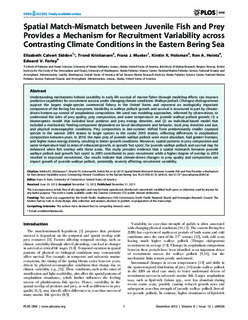| dc.contributor.author | Siddon, Elizabeth Calvert | |
| dc.contributor.author | Kristiansen, Trond | |
| dc.contributor.author | Mueter, Franz J. | |
| dc.contributor.author | Holsman, Kristin K. | |
| dc.contributor.author | Heintz, Ron A. | |
| dc.contributor.author | Farley, Edward V. | |
| dc.date.accessioned | 2014-02-06T13:10:20Z | |
| dc.date.available | 2014-02-06T13:10:20Z | |
| dc.date.issued | 2013-12-31 | |
| dc.identifier.citation | Siddon EC, Kristiansen T, Mueter FJ, Holsman KK, Heintz RA, et al. (2013) Spatial Match-Mismatch between Juvenile Fish and Prey Provides a Mechanism for Recruitment Variability across Contrasting Climate Conditions in the Eastern Bering Sea. PLoS ONE 8(12): e84526. doi:10.1371/journal.pone.0084526 | no_NO |
| dc.identifier.issn | 1932-6203 | |
| dc.identifier.uri | http://hdl.handle.net/11250/109325 | |
| dc.description.abstract | Understanding mechanisms behind variability in early life survival of marine fishes through modeling efforts can improve predictive capabilities for recruitment success under changing climate conditions. Walleye pollock (Theragra chalcogramma) support the largest single-species commercial fishery in the United States and represent an ecologically important component of the Bering Sea ecosystem. Variability in walleye pollock growth and survival is structured in part by climate-driven bottom-up control of zooplankton composition. We used two modeling approaches, informed by observations, to understand the roles of prey quality, prey composition, and water temperature on juvenile walleye pollock growth: (1) a bioenergetics model that included local predator and prey energy densities, and (2) an individual-based model that included a mechanistic feeding component dependent on larval development and behavior, local prey densities and size, and physical oceanographic conditions. Prey composition in late-summer shifted from predominantly smaller copepod species in the warmer 2005 season to larger species in the cooler 2010 season, reflecting differences in zooplankton composition between years. In 2010, the main prey of juvenile walleye pollock were more abundant, had greater biomass, and higher mean energy density, resulting in better growth conditions. Moreover, spatial patterns in prey composition and water temperature lead to areas of enhanced growth, or growth ‘hot spots’, for juvenile walleye pollock and survival may be enhanced when fish overlap with these areas. This study provides evidence that a spatial mismatch between juvenile walleye pollock and growth ‘hot spots’ in 2005 contributed to poor recruitment while a higher degree of overlap in 2010 resulted in improved recruitment. Our results indicate that climate-driven changes in prey quality and composition can impact growth of juvenile walleye pollock, potentially severely affecting recruitment variability. | no_NO |
| dc.language.iso | eng | no_NO |
| dc.publisher | Public Library of Science | no_NO |
| dc.title | Spatial Match-Mismatch between Juvenile Fish and Prey Provides a Mechanism for Recruitment Variability across Contrasting Climate Conditions in the Eastern Bering Sea | no_NO |
| dc.type | Journal article | no_NO |
| dc.type | Peer reviewed | no_NO |
| dc.subject.nsi | VDP::Agriculture and fishery disciplines: 900::Fisheries science: 920::Resource biology: 921 | no_NO |
| dc.source.pagenumber | 13 p. | no_NO |
| dc.source.volume | 8 | no_NO |
| dc.source.journal | PLoS ONE | no_NO |
| dc.source.issue | 12 | no_NO |
| dc.identifier.doi | 10.1371/journal.pone.0084526 | |
